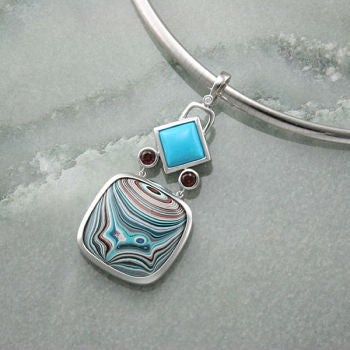 Fordite, incorporated in metal with other stones. Courtesy of Devon Fine Jewelry.
Fordite, incorporated in metal with other stones. Courtesy of Devon Fine Jewelry.
Remember that 1964 Ford Mustang you pined after as a teen? Yeah, that’s the one—the sweet red convertible you saved up for, busing trays for tips at the local soda shop, but never could afford? It can be yours now, along with many other classic models…well, in keepsake form, that is.
A manmade material called fordite—used in all types of jewelry, from lady’s pendants to men’s rings—preserves a slice of automotive history under its polished surface. No, it doesn’t consist of a shattered headlight, melted into cabochon form. This gem of a stone reveals its history through multiple layers of colorful paint scavenged from the very factory that led to Steve McQueen’s ride in
Bullit and my own father’s Shelby GT infatuation.
Back in the 1950s and 1960s, vehicles passing through Ford assembly lines reached a booth where men with paint guns sprayed them various colors. The paint inevitably accumulated on the racks holding the cars, building up, layer upon layer. Considered as industrial waste, most workers overlooked the hardened paint until cleaning time. Some factory men, however, fortuitously shared a particular hobby that grew out of 1940s California—cutting and polishing stones, an art practiced by lapidaries. They eventually realized that the sheets of pigment others might consider trash could actually be fashioned into treasure and started mining away. When the material is cut, “it looks just like a really finely banded stone—like an agate,” says
Gary Wilson, a lapidary who works with fordite. “It’s just a unique recycled material that most people paid no attention to in the era it was being produced.”
Also called “Detroit agate” and “Motor City agate,” the stone comes in various color combinations, depending on what hues were popular at the time. Picture hippie-ish hallucinogenic swirls in rust, light blue, golden-copper, and silver, and you’ve got the small, lightweight piece sitting in front of me right now. “[Fordite’s] got a lot of pattern and color," says Wilson, and "when [people] first see it, [they] go ‘Wow!’” Though the stone’s muscle car colors woo the men, jewelry made with fordite also appeals to the fairer sex. “I’m continually amazed by how many women like it,” says Nancy Schuring, president of
Devon Fine Jewelry who shared the cabechon I have here and who purchases stones from Wilson.
Because paint guns in auto factories are a thing of the past—nowadays, cars receive their coats through an electrostatic process—classic fordite is a finite commodity, stashed in various locations. Body and bumper shops, however, still paint cars using methods that can result in layered paint accumulations, and now a modern version of fordite is available, although it isn’t as appealing, according to Wilson. “You can really tell the authentic stuff from the more recent material that occasionally surfaces,” he says. The texture is different, and it consists of “typical colors of cars you’ll see on the road today”—i.e., black, white, and silver (yawn). There’s also a rival fordite, called Chevyite, but the source is much smaller, and its colors aren’t as clearly defined, says Wilson.
Okay, so this stone is beguiling, but should consumers worry about any lead content? Wilson suspects the paint is enamel-based. But even if it weren’t, “if there were any danger, it would be in the cutting process rather than after the stone is finished,” he says. “It’s completely inert then.” And any prudent lapidary “always wears a mask, and the material is cut and polished wet, so there’s no dust to breathe,” he adds.
Born in 1953 in Owasso, Michigan, Wilson discovered his passion for stones at an early age—but those made in nature, not factories. “I clearly remember fordite being around and readily available if anyone cared for it,” he says, “[but] I kind of snoofed my nose at it because it wasn’t a rock; I was a purist in those days.” Now he sees virtue in the scavenged stuff. “It’s a little slice of Americana, really,” he says. Plus, it’s “one of the coolest recycled materials of all times.” And at around $45-$75 for stone, it’s still a lot more affordable than that red dream ride.


